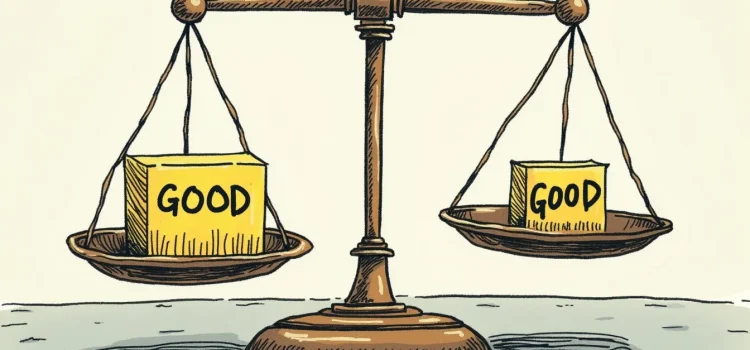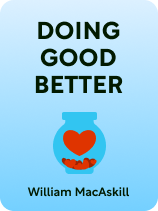

This article is an excerpt from the Shortform book guide to "Doing Good Better" by William MacAskill. Shortform has the world's best summaries and analyses of books you should be reading.
Like this article? Sign up for a free trial here.
Should you splurge on a nice dinner—or eat at home and donate the money you saved? Should you use your time to volunteer at a soup kitchen or an afterschool program?
William MacAskill points out that each of us is faced with decisions about how to spend our time and money. To make such choices, he suggests we consult the first principle of effective altruism: Perform the action that maximizes the net benefit to humanity.
Continue reading to learn what it means to do the most good, according to the philosophy of effective altruism.
Doing the Most Good
To see how intuitive the principle of doing the most good is, consider wartime doctors who are forced to decide which patients to treat. Inevitably, they can’t treat everyone—some patients have fatal injuries beyond treatment. Further, other patients deserve priority treatment—if forced to choose between caring for one patient who will die without treatment, and five with minor injuries who will survive regardless, it makes sense to treat the former. In other words, these doctors try to treat patients in a way that maximizes lives saved since their resources are limited.
(Shortform note: According to experts, health care professionals faced similar decisions to wartime doctors during the Covid-19 pandemic, in which limited resources such as hospital beds and ventilators meant doctors had to decide how to allocate these resources. Ultimately, these doctors embraced reasoning similar to that of wartime doctors, choosing to prioritize individuals most likely to have the highest amount of healthy years post-treatment. So, more generally, they made decisions in line with the principle to maximize the net benefit to humanity.)
MacAskill suggests that, analogously, we should use our resources to maximize net good. For example, although we aren’t dividing our time between wartime patients, we do divide our time between different pursuits; some of us might choose to volunteer at a blood drive, while others might choose not to volunteer. Likewise, some of us might choose to spend our money donating to international charities, while others choose to spend it on luxury cars. In both cases, our guiding principle should involve maximizing the total good we’re doing for humanity.
(Shortform note: Philosopher Peter Singer first defended a similar principle in his 1972 essay, “Famine, Affluence, and Morality.” Singer argued by analogy, suggesting that if we saw a child drowning in a pond, we would be obligated to rescue them since it causes us only a small inconvenience—we might ruin a nice outfit, for example. In turn, he suggests that similar considerations make us obligated to donate our disposable income, because our donations can save lives that we would have otherwise spent on small luxuries, like a slightly nicer car or an expensive vacation.)
How to Use Quality-Adjusted Life Years to Maximize the Good to Humanity
Nonetheless, MacAskill acknowledges that it’s difficult to measure the impact of different actions—for instance, how should we determine the impact of funding a charity that distributes malaria nets versus one that funds sex education programs? To do so, he recommends that we estimate the quality-adjusted life years (QALYs) associated with a given action to inform our decision.
QALYs, MacAskill relates, refer to a combination of the time that we can extend someone’s life multiplied by the quality of that life during that time (typically measured on a subjective scale of one to 10). For example, suppose that medication for AIDS could increase someone’s quality of life from a three out of 10 to an eight out of 10 over five years. Then, this medication would have a net increase of five out of 10 (50%) times five years, meaning it yields 2.5 QALYs.
(Shortform note: In health economics, an alternative measure to QALYs is known as willingness to pay (WTP)—the average amount that a consumer would be willing to pay to rid themselves of an ailment. For example, in Japan surveys revealed that consumers would on average pay $30 to relieve themselves of cold symptoms, compared to $2,200 to treat a detached retina, suggesting that the latter is some 70 times worse than the former. In this manner, WTP provides a different metric for assessing the impact of different health treatments.)
MacAskill says that by estimating the QALYs associated with different donations and actions, we can estimate which yields the greatest benefit. For example, imagine that you’re deciding between donating $5,000 to an organization fighting homelessness and donating $5,000 to an organization that funds cochlear implants for deaf people. You might estimate that $5,000 donated to the organization for homelessness will yield 0.3 QALYs times two years (0.6 total QALYs), while $5,000 donated to the organization for cochlear implants will yield 0.2 QALYs times six years (1.2 total QALYs). In this case, you should donate to the organization for deaf people, as it delivers a greater increase in QALYs.

———End of Preview———
Like what you just read? Read the rest of the world's best book summary and analysis of William MacAskill's "Doing Good Better" at Shortform.
Here's what you'll find in our full Doing Good Better summary:
- How you can save hundreds of lives by being a good person
- The principles behind the effective altruism movement
- How to determine which charities are worth funding






